Kidney failure, otherwise known as renal failure, is one of the most common causes of illness and death in older cats. The good news is that natural treatments and prevention protocols can help slow its progress.
Annette’s two cats are 14 years old, and both have been diagnosed with kidney failure. Dismayed and puzzled, she wanted to know if it was just a fluke. Unfortunately, it isn’t. Chronic kidney failure is very common in older cats. In one study of cats affected with the condition, 37% were less than ten years old, 31% were between 10 and 15, and 32% were older than 15. Since this disease is so frequently seen in felines – and is the second-leading cause of death – early diagnosis and treatment is imperative.
Looking at causes
Kidney disease is a starting point for kidney failure. As a cat ages, his kidney function begins to deteriorate at some point. Because the kidneys are able to function even when only a small amount of normal kidney tissue remains, the disease usually progresses to early kidney failure (when 60% to 75% of the kidney tissue is no longer functioning properly) by the time it’s diagnosed.
Kidney failure can be divided into two types:
- Acute kidney failure is usually due to an infection or poisoning.
- Chronic kidney failure occurs frequently in middle-aged and older cats. There is usually no identifiable cause. It’s mainly a case of “old cats with old kidneys”; it occurs as aging kidney tissue becomes no longer able to adequately remove toxic wastes from the body.
Certain breeds are prone to specific diseases which can lead to chronic kidney failure. Renal amyloidosis occurs in Abyssinian cats, while polycystic kidney disease occurs in Persians. Himalayan, Siamese, Persian and mixed breeds appear to be at increased risk for both kidney disease and failure.
Conventional treatments are limited
Chronic kidney disease or failure cannot really be successfully treated with any conventional therapies, and the only therapies routinely used are often of no value until the cat is in middle to late stage kidney failure.
When the cat begins to show early kidney disease/failure through mild changes in his blood and urine, conventional veterinarians cannot recommend any therapy other than possibly switching the cat to a prescription-type kidney diet. At this stage, however, natural therapies can be of great value in slowing the disease’s progression (see next section).
While medications such as aluminum hydroxide (which reduces phosphorus levels in the blood) and intravenous or subcutaneous fluids (which cause dieresis and flush toxins out of the body) are helpful, they do not really address the underlying problem. Nevertheless, these treatments, especially fluid therapy, can be lifesaving for cats with kidney failure. I see wonderful results by combining fluid therapy with the natural therapies listed below. If you can administer fluids at home along with the prescribed natural therapies, your cat can often live a normal life until he passes from “old age”.
Natural route is best
Several different natural treatments, in addition to fluid therapy, can help cats with kidney disease or failure.
- Fish oil is wonderful for reducing inflammation anywhere in the body. It results in fewer inflammatory chemicals produced by the body, and makes cell membranes more “fluid”, allowing them to more effectively communicate with each other.
- Antioxidants, including vitamins A, C and E as well as resveratrol, coenzyme Q10, and bioflavonoids, reduce cell damage caused by the oxidative chemicals that form when cells are injured or die.
- Herbs such as Chinese rhubarb, astragalus, rehmannia formulas, goldenrod, dandelion, horsetail and marshmallow help reduce further damage to the kidneys, increase diuresis (urination) to remove toxins from the body, and lubricate the urinary system.
- Homeopathics such as Berberis and Cantharis are used for detoxification as well as healing damaged kidneys. To simplify treatment and allow the use of a greater number of homeopathic remedies in a single product, I prefer to use homotoxicology formulas manufactured by Heel. These include Solidago compositum, Berberis homaccord, Belladonna homaccord and Reneel. They allow for detoxification, encourage urination, reduce inflammation and promote healing of the urinary system.
A natural diet will reduce toxins such as the by-products and chemicals found in poor quality foods.
Can kidney failure be prevented?
It may be possible to prevent or at least delay the onset of kidney disease or failure. However, there is no way to stop kidneys from aging as the cat gets older. Having said that, there are things you can do before your cat develops the condition or even in the early stages of the disease.
- A natural diet will reduce toxins such as the by-products and chemicals found in poor quality foods. Minimizing these ingredients helps prevent kidney damage. Wet food is preferable because it encourages urination, which removes toxins from the body. Fish oil supplements and antioxidants reduce inflammation and oxidative damage.
- While vaccines are not directly toxic to the kidneys, they should be avoided in older cats and should never be given to those with kidney failure.
- The best way to help a cat with kidney disease or failure is by early diagnosis. Beginning at five years of age, your cat should be examined by the veterinarian twice a year; blood and urine testing should be done at this age as well. As soon as signs of early kidney disease/failure are diagnosed (through an increase in BUN and creatinine values in the blood, and a decreasing specific gravity and increasing protein in the urine), the natural therapies discussed here can slow down its progression.
Feline kidney disease is common and serious, but it need not be a death sentence. A good diet, early diagnosis and natural treatments can slow it down and keep your kitty comfortable and happy for a long time to come.







This is true. My two girls suffered from kidney disease and one lived to be 13 and the other 18.